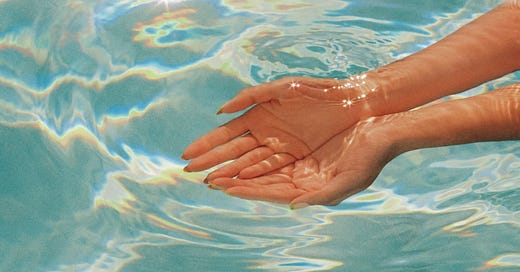I can’t remember the exact moment I decided to be a writer.
It didn’t hit me like a wave, or strike like a lightning bolt. It was more of a gentle but persistent stirring. A tug, of sorts, from a deep place of knowing that had always been there.
I’m going to hazard a guess — based on the fact you’ve decided to read this post — that you have a place like that, too.
It’s the one that comes alive when you give yourself a chance to be still — distraction free — and just make. The one that feels tapped into… something… guiding pen to paper, paint to brush, notes to tune, fingers to keyboard, new solution to old problem.
It’s where time evaporates. Some call it the zone, some call it a dance with the divine, others call it a feat of pure cognition.
I just call it my happy place.
And it’s a place I left to gather dust for a long time. So, coming home to it didn’t feel so much a decision as an acceptance; a submission, really. After fighting it for years under the guise of impressive-on-paper jobs in fancy PR agencies and in-house global marketing teams.
To be clear, they were great jobs. I learned a lot. I wrote a little. Enough, I thought, to keep my creative cravings at bay – but inevitably, I’d be proven wrong.
So into the ether of uncertainty, I leapt.
But here’s the truth about leaping: it’s only the first step. What happens afterward is its own kind of challenge. Yes, writing full-time is a privilege—unburdened by corporate agendas, KPIs, or someone else’s voice in my ear. But just because you’ve cleared external barriers doesn’t mean you’re shielded from the internal ones.
These days, the barriers look different: procrastination scrolling, ‘doom-spirational’ content, and a constant stream of productivity hacks—all meant to inspire but often leaving me feeling overwhelmed at best. It’s ironic, isn’t it? The very platforms that promise to spark creativity often smother it instead, burying your original voice under a mountain of algorithms and curated opinions.
So how do we protect our creative sanctity? How do we resist the lure of AI-generated prompts, curated ideas, and endless commentary that erode the essence of our own voices? The way forward, I think, is to slow down enough to listen—to pause between the buzz of notifications and the urge to 'stay relevant.' In my experience, it’s in those gaps where the quiet — and the magic — starts to seep back in.
I haven’t perfected this, far from it. But here are a few practices that have helped me reclaim that happy place, if only temporarily:
Daily moments of nothingness: Yes, you read that right. Moments of nothingness. Not glamorous, also not easy — but necessary. I spend a few minutes each day sitting quietly, without a plan or purpose — and critically, without my phone in reach. It’s often uncomfortable, but it’s a reset button for my often overworked mind.
Constraints on consumption: I limit my social intake to a couple of trusted sources. I deleted Facebook years ago, Instagram & LinkedIn share a daily 15 minute limit, and I’m cautiously lure of TikTok’s abyss. Even — dare I say it — Substack’s notes platform is one for me to watch lately, and I’m considering deleting the app from my phone to encourage more mindful use. It’s less ‘inspo,’ less external advice — and more focus, more tuning in.
Tech sabbaticals: I’m talking phone off and in another room. Because honestly, if it’s on and within reach — my brain will engineer a reason to pick it up and turn it on. And the longer you can go without IMHO, the better… Not just the mornings—whole days or weekends without devices, giving creativity (and your brain/attention span in general) space to breathe.
If we want to create work that’s authentic and true—work that feels like ours—we have to fiercely guard that happy place. It’s where the magic lives, where ideas take root and bloom. It’s also fragile, prone to interference from all the digital noise and well-meaning advice. But if we protect it, it rewards us with the richest form of fulfilment — the kind that connects you to fellow humans.
So here’s to more creating and less consuming. To fewer distractions and more room for your wild, wonderful ideas. And to finding your own happy place—whatever it looks like, wherever it is.
How do you juggle creativity and consumption in the attention economy? I’d love to hear your thoughts below. It’s a safe space, promise! x






This discussion is an important one - I came across a creator on TikTok (@Vanessadomslife) who talks about creating art as adults. We think that it should be like when we were kids - that we just feel inspired and then create. Instead, she urges people to think about carving out time to create, understanding that we won't get very far if we rely on inspiration alone.
I loved reading this & totally resonate with so much of your experience. I have to be really mindful of what I engage with in general, but especially at some points in my menstrual cycle where I’m way more sensitive to external information. It’s a real commitment to creating as our true selves, isn’t it x